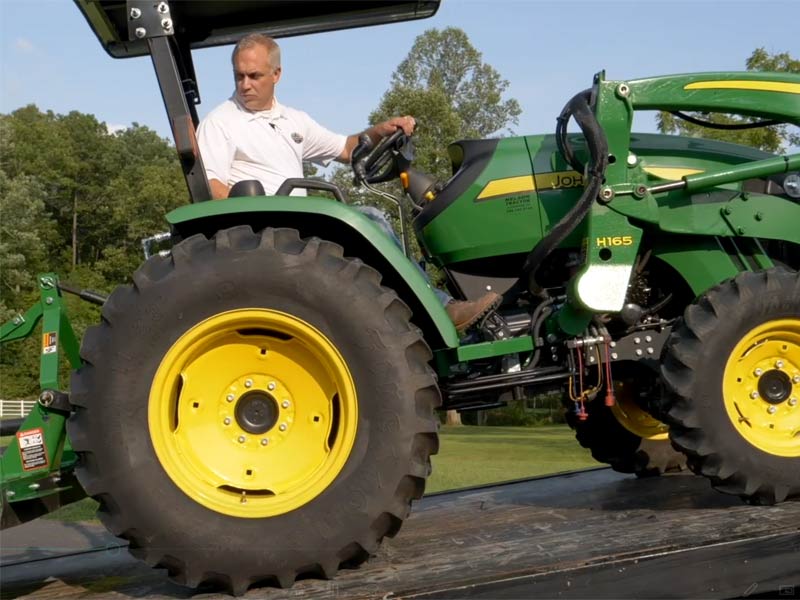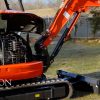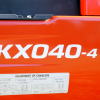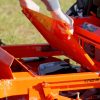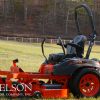Tractors are the most common piece of farm equipment in use today and are essential to a huge number of daily tasks performed on the farm. They provide the power that is necessary for high production agricultural operations. They are used to transport supplies, materials, equipment, and machinery, pull tillage equipment, and act as a power source for other pieces of farm equipment.
Manufacturers are constantly developing improvements to tractor design to make them safer, but there are still many accidents involving tractors every year. These accidents can result in major, disabling injuries, or even death. They can create substantial losses for a business due to medical bills, time off work, property damages, decreased productivity, and insurance costs.
The primary causes of tractor related accidents are rollovers, falls, and contact with attachments. Since it has yet to be discovered how to build a tractor system that can recognize unsafe conditions, anyone who operates a tractor should be knowledgeable of their machine and the hazards of use. It is also important to maintain the tractor in good working condition and not to push the boundaries when it comes to running and repairing the machine. This will help tractor operators prevent mistakes and accidents from occuring.
Training and Prep
Anyone who works with a tractor should be properly trained and extremely familiar with the operator’s manual for the specific tractor and equipment. Study the manual with the tractor in front of you to learn both the manual and the equipment. You’ll learn the location and functions of every control, gauge, and other indicators. Familiarizing yourself with this information will make reaction time much quicker in an emergency situation. Keep an operation manual handy for a fast reference.
It’s important to wear the appropriate clothing at all times while operating a tractor. Fitted pants and a tucked-in shirt will remove the chance of loose fitting clothing getting caught into any part of the machine. You should always wear sturdy, steel-toe work shoes or boots. Heavy gloves and safety glasses may also be useful depending on the job at hand.
Another thing farmers should always do before getting started is to perform a pre-operational tractor safety check to assure that your machine is in a safe working condition.
Check the tires to ensure they are properly inflated and there are no leaks, bumps, or embedded debris – you don’t want to find a nail in your tire out in the field. Clean windows, mirrors, and reflectors, check the seat belts, seat position, brakes, steering response, and lights.
Walk around the tractor and check the hitch, the power takeoff shaft, and look at the ground beneath it to check for any kind of leak. Check the oil, radiator, fuel level, air cleaner, and fire extinguisher. Take note of any defects you may come across and have them fixed immediately.
How to Avoid Rollovers
Rollovers or overturns are the most common type of tractor related accident, and the most common of these are side overturns. These accidents can be fatal, or result in crippling injuries. They also can cause significant and costly property damage.
Rollovers are normally caused by:
- Driving the tractor too fast for conditions
- Running into hazards on a surface such as holes, stumps, or large rocks
- Driving into ditches or on steep slopes
- Improperly operating front-end loaders.
Tractor operators can take precautions to help prevent a potential rollover. To start, being mentally and physically fit can reduce human mistakes while operating. Factors like poor attitude, poor judgment, fatigue, stress, intoxication, showing off, or lack of knowledge creates opportunity for operator error that can result in an accident.
While operating the tractor, there are many things you can do to enhance tractor safety and help prevent rollovers. Here are a few tips:
- Be aware of your surroundings – How steep is the slope? Is the ground wet and soft? Are there obstacles in your path?
- Properly stabilize the tractor – make sure your load is balanced, not too heavy for your tractor and keep the bucket low during transport.
- Back carefully up steep hills and keep to a slow speed. Come down forward, and just as slow. If you must turn on a slope, turn downhill rather than uphill. If a side-mounted tool is attached to your tractor, keep the implement on the uphill side.
- Change tractor speed by smoothly applying power at a gradual rate.
- Drive at appropriate speeds. Faster speeds decrease the stability of the tractor and increase your risk of rolling over.
- Avoid driving on the edges of the road where shoulders might be soft, sloped, or there may be a ditch.
- Never hitch a towed load higher than the tractor drawbar. Hitching too high is major cause of rearward tractor flips.
- Use counterweights to increase tractor stability. Check your owner manual for specifics.
Tractors with 2-wheel drive are more susceptible to rear rollovers, but any tractor can flip over backwards. This is most likely to happen when:
- Freeing a stuck tractor
- Raising rear-mounted equipment
- Using a front-end loader
- Hitching above the drawbar
- Operating on an incline
Some tractors are equipped with ROPS, or Roll-Over Protection Structures. These structures built around the operator compartment of the tractor and can eliminate practically all rollover fatalities.
Mounting and Dismounting a Tractor
Another common cause of tractor related injuries is falling from the machine while mounting or dismounting. Always use the steps of the tractor like steps on a ladder, two hands and one foot should be in contact with the ladder at all times, or two feet and one hand. Make sure all parts of your clothing are away from the pedals when exiting the tractor, to prevent tripping. Unless the tractor is equipped with a buddy seat, never carry extra passengers. Heavy machinery should only carry as many passengers as it has seat belts.
Operating Safety
When you are starting the tractor, only do so from the operator’s platform. If it is indoors, you must always make sure you have plenty of ventilation. Carbon monoxide from the exhaust is dangerous to breathe.
Check the power takeoff controls and make sure that they are disengaged, the clutch is depressed, and the transmission is in neutral.
Start the engine as in compliance with the operator’s manual and allow the engine to warm up. Inspect all of the instruments. Confirm there is proper oil pressure and that the battery is charging.
During operation of the tractor, first make sure that the seat is adjusted to where you can reach all pedals and controls. Adjust all mirrors and confirm you have optimal visibility all around you.
Engage power to the wheels slowly and test your brakes and steering wheel while moving at a very slow speed. If either seem to have a problem, stop the tractor immediately. If there is a load attached, make sure it is hitched securely to the drawbar.
Any time you tow a vehicle heavier than the tractor itself, it must have its own separate braking system for safe operation. Using the braking power of the tractor’s engine can prevent a runaway tractor or an overturn. To maintain good control while driving downhill, stop and shift into a low gear.
When hitching equipment, make sure the area around the tractor is clear, then slowly back the tractor up to the implement. Engage the emergency brake and put the transmission in neutral. Once you’ve done that, you can dismount the tractor and hitch up the equipment.
Shutting Down
When shutting the engine off, always allow it to run on idle first to cool off. After the engine is shut off, make sure the parking brakes are locked before refilling the fuel tank. Remove any nearby debris that could potentially combust near the exhaust system.
The higher the quality of the tractor, the fewer hazards you will face; however, any machine can be dangerous and potentially life threatening if the recommended procedures of operation are not properly followed. Safety begins with you, the operator of the tractor.The higher the quality of the tractor, the fewer hazards you will face; however, any machine can be dangerous and potentially life threatening if the recommended procedures of operation are not properly followed. Safety begins with you, the operator of the tractor.
Don’t take any shortcuts, take breaks if you feel exhausted, and be knowledgeable of your farming equipment and jobs. The operator’s manual contains all the information you need to be a safe and responsible operator. Skill, common sense, and most importantly, knowledge, are your keys to tractor safety and successful operation.
References:
Preventing tractor overturn incidents. (2013). Farm and Ranch eXtension in Safety and Health (FReSH) Community of Practice. Retrieved from http://www.extension.org/pages/68324/preventing-tractor-overturn-incidents
Farm Safety Association Inc. Prevent Tractor Overturns
John Deere Tractor Safety & Training
Kubota’s Ten Commandments of Tractor Safety


